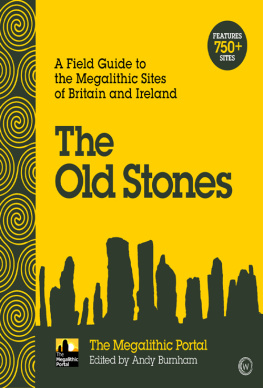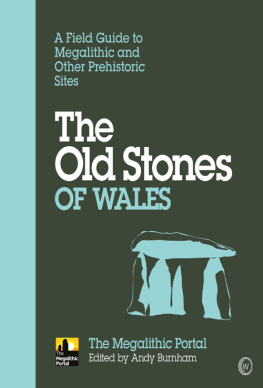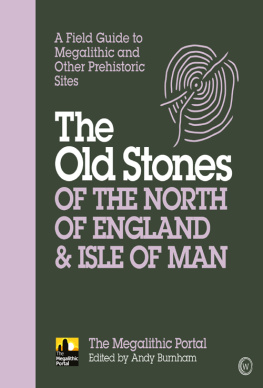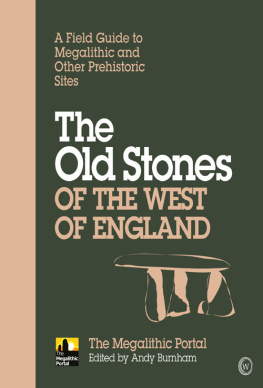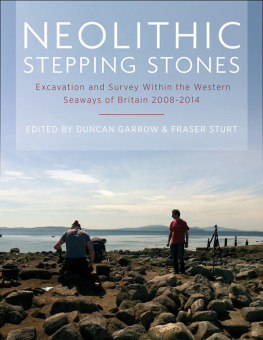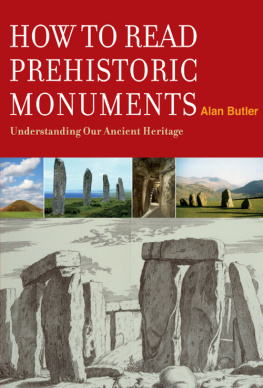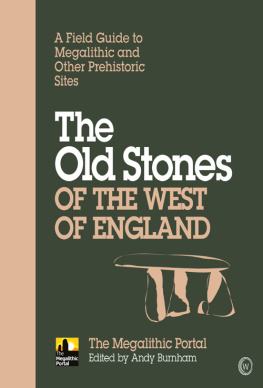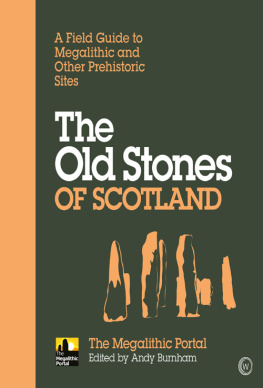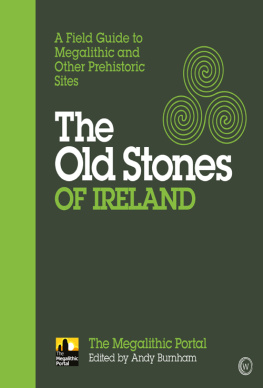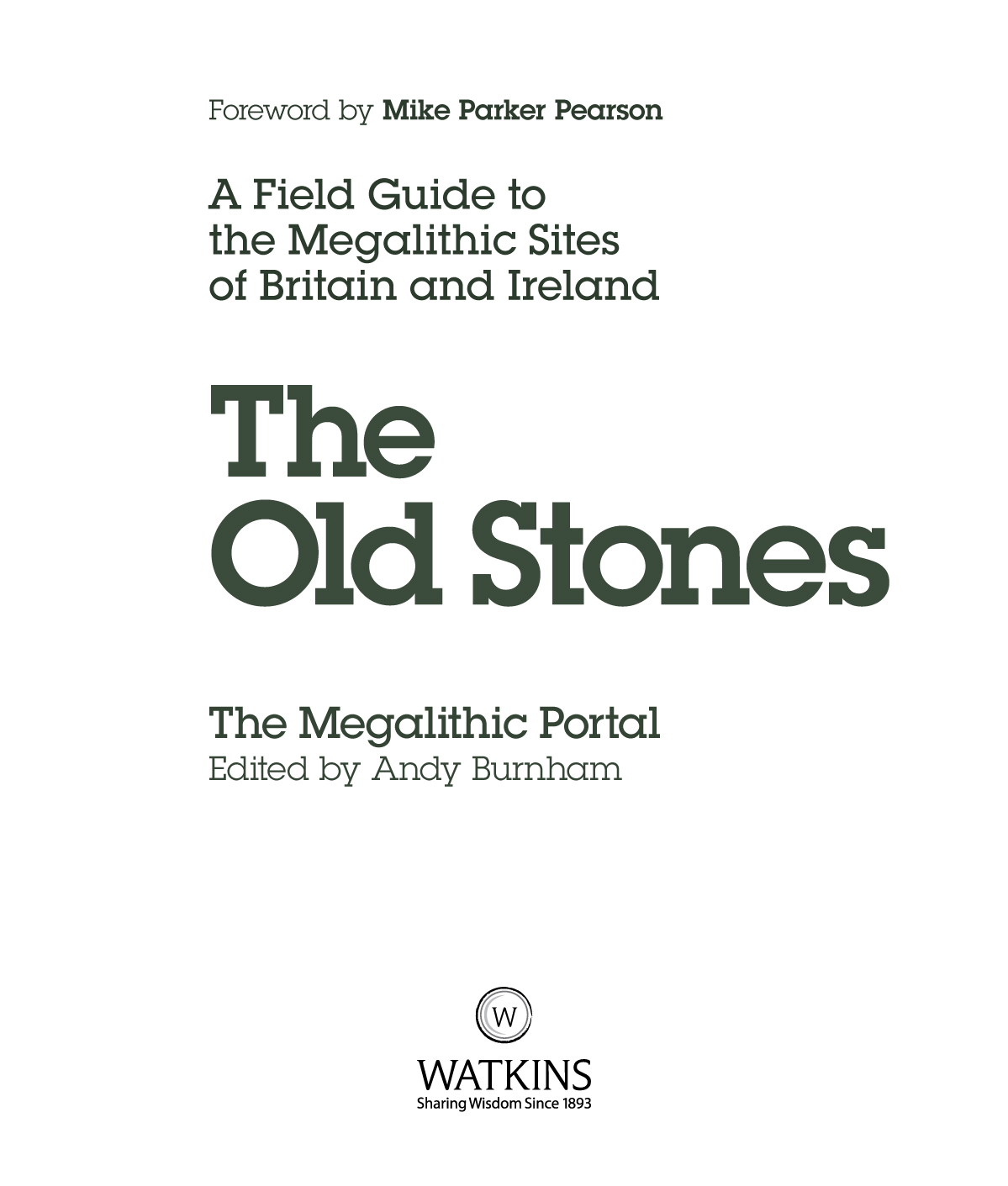Dedication
This book is dedicated to all Megalithic Portal contributors, especially those who have passed to the realms of the ancestors.
Tom Bullock (Tom_Bullock), who visited more than 1,200 stone circles to create his CD-ROM guide
Jack Morris-Eyton (JackME), who spent years developing his intriguing theory about shadow casting at megalithic sites (see )
Holger Rix (Holger_Rix), who contributed around 4,500 images and over 6,300 site pages from all over Europe
The Old Stones
The Megalithic Portal
Edited by Andy Burnham
First published in the UK and USA in 2018 by
Watkins, an imprint of Watkins Media Limited
Unit 11, Shepperton House, 8993 Shepperton Road
London N1 3DF
Design and typography copyright Watkins Media Limited 2018
Foreword copyright Mike Parker Pearson 2018
Introduction copyright Andy Burnham 2018
Imagining Prehistoric Landscapes copyright Vicki Cummings 2018
Feature boxes and site entries by named contributors copyright each named contributor 2018
All other text copyright Watkins Media Limited and the Megalithic Portal 2018
Artwork copyright Watkins Media Limited 2018, except for the following illustrations:
p.45(l) copyright Roy Goutt; p.96 copyright Jon Morris; p.271 copyright Angie Lake; p.308 copyright Gail Higgenbottom
Photography copyright each named photographer 2018
Maps created with QGIS mapping software. UK map backgrounds Ordnance Survey Open Data, Crown copyright and database right (2018)
The right of the Megalithic Portal to be identified as the Author of this text has been asserted in accordance with the Copyright, Designs and Patents Act of 1988.
All rights reserved. No part of this book may be reproduced in any form or by any electronic or mechanical means, including information storage and retrieval systems, without permission in writing from the publisher, except by a reviewer who may quote brief passages in a review.
Commissioning Editor: Fiona Robertson
Editor: Jackie Bates
Proofreader and Indexer: James Hodgson
Senior Designer: Francesca Corsini
Head of Design: Georgina Hewitt
Production: Uzma Taj
Map Design: Andy Burnham
Commissioned Artwork: Jay Kane
A CIP record for this book is available from the
British Library.
ISBN: 978-1-78678-154-3
10 9 8 7 6 5 4 3 2 1
Typeset in ITC Lubalin Graph
Colour reproduction by XY Digital
Printed in Hong Kong
www.watkinspublishing.com
Note: Site information is correct to the best of our knowledge at the time of going to press, but it is advisable to check access details before visiting. Inclusion in this guide does not imply a site has public access or is safe to visit.
Contents
FOREWORD
Mike Parker Pearson
INTRODUCTION
Andy Burnham
Photogrammetry
Hugo Anderson-Whymark
IMAGINING PREHISTORIC LANDSCAPES
Vicki Cummings
Fighting Moorland Enclosure in Penwith
Ian McNeil Cooke
Strange Experiences at Ancient Sites
Rune
The Rough Tor Triangle: A Theory
Roy Goutt
Under the Supermarket
Andy Burnham
The Stone Rows of Dartmoor
Sandy Gerrard
The Cist on Whitehorse Hill
Andy Burnham
The Miniliths of Exmoor
Martyn Copcutt
Top 10 Pieces of Music Inspired by Prehistory
Andy Burnham
Stonehenge: Model of a Geocentric Universe?
Jon Morris
Stonehenge and the Neolithic Cosmos
N.D. Wiseman
Feasting and Monument Building
Barney Harris
Cats Brain: A House for the Living?
Andy Burnham
Development of the Avebury Landscape
Joshua Pollard
Unique Transfigurative Rock Art?
Terence Meaden
Archaeoacoustics
Steve Marshall
Dorstone Hill: A Unique Configuration of Monuments
Andy Burnham
Looking to the Land of the Ancestors
Vicky Tuckman
A Phenomenology of Shadow
Daniel Brown
Icknield Way: Ancient Track or Medieval Fantasy?
Keith Fitzpatrick-Matthews
Must Farm: An Extraordinary Fenland Survival
Jackie Bates
Chalk Artefacts
Anne Teather
Insights from a Bronze Age Timber Circle
Andy Burnham
Propped Stones
David Shepherd
Thornborough Archaeoastronomy
Andy Burnham
Neolithic Sites in the Landscape
Cathryn Iliffe
The Gypsey Race
Chris Collyer
Stone Axes
Leslie Phillips
Jack Morris-Eytons Shadow Theory
David Smyth
Prehistoric Rock Art in Britain and Ireland
Cezary Namirski
Translating Welsh Place Names
Simon Charlesworth & Stephen Rule
Bancbryn Stone Row
Sandy Gerrard
A Phenomenological Approach to Dolmens
Vicki Cummings
Stonehenge and the Glacial Transport Theory
Brian John
Healing Stones? The Preseli Bluestones
Julie Kearney
Bringing the Neolithic Back to Life
Martyn Copcutt
Colour in the Monuments of Neolithic Europe
Penelope Foreman
Stone Circles
John Barnatt
Dowsing at Cairn Holy
Angie Lake
Hidden Evidence: The Lochbrow Project
Kirsty Millican
Top 10 Urban Prehistory Sites
Kenneth Brophy
The Lives of Stones
Anne Tate
Investigating the Forteviot Ceremonial Landscape
Andy Burnham
Archaeoastronomy in Western Scotland
Gail Higginbottom
Carved Stone Balls
Julie Kearney
Recumbent Stone Circles
Adam Welfare
Skyscape Archaeology at Tomnaverie
Liz Henty
What is the Lunar Standstill?
Vicky Tuckman
The Song of the Low Moon
Grahame Gardner
Excavations at the Ness of Brodgar
Andy Burnham
An Early Neolithic House at Cata Sand
Vicki Cummings
Lithic Symbolism at Drombeg
Terence Meaden
The Art of the Boyne Valley
Robert Hensey
Modified Boulders of the Cavan Burren
Gaby Burns
Foreword
Mike Parker Pearson, Professor of British Later Prehistory at University College London
Megaliths are among the most enduring remazins from our prehistoric past. Whether as single standing stones or impressive stone circles and tombs, they provide a glimpse into a vanished way of life that may seem beyond our comprehension. Yet, as Vicki Cummings points out so well in her introduction to this book, megalithic monuments represent the tip of the iceberg in terms of what has survived from thousands of years ago. Thanks to advances in archaeology, both technical and organizational, we are learning much about the people who built the megaliths. The remains that usually survive only below ground the houses, portable material culture, non-megalithic monuments and environmental evidence are becoming better understood. Thanks to analyses of chemical isotopes and ancient DNA, we are learning about the people themselves who their ancestors were, where they came from and how mobile they were. With the application of so many new scientific methods, this is an exciting time to be an archaeologist.
Even as I write, new results from ancient DNA analysis are revealing that Britains Neolithic inhabitants show little evidence of genetic mixing with the indigenous Mesolithic huntergatherers who lived in Britain before the arrival of agriculture. These Neolithic farmers, in turn, appear to have been substantially replaced by the Beaker people and their Bronze Age descendants; current evidence suggests that, by 1500BC, only 10 per cent of peoples genes derived from the previous Neolithic population of Britain. Isotope analyses also show that these prehistoric people were highly mobile in all periods from the Neolithic to the end of the early Bronze Age. Megaliths would have been some of the few human-constructed fixed points in their lives.

